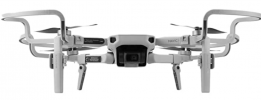So I cant find the video I saw this but the FAA guy was saying that the new regulations will break drones down into 4 categories. The first one being recreational AKA exempt if under 249g. Basically he was saying that even if your drone qualifies for exempt status, they will require prop guards. Which means it will weight more, which will then mean it has to be registered. Which would then kick it into category 2?
Does anyone know if this is true? I mean as the actual law goes. Can Mr. Ranger write me a ticket some day for not having prop guards on my Mini?
"Category 1 small unmanned aircraft are permitted to operate over people, provided..." "Weigh 0.55 pounds or less," "Contain no exposed rotating parts that would cause lacerations"
Does anyone know if this is true? I mean as the actual law goes. Can Mr. Ranger write me a ticket some day for not having prop guards on my Mini?
"Category 1 small unmanned aircraft are permitted to operate over people, provided..." "Weigh 0.55 pounds or less," "Contain no exposed rotating parts that would cause lacerations"


















